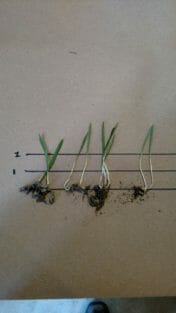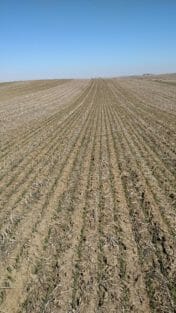Oats slow to emerge?
Oats used to cover nearly 7 million acres in Iowa back in the 1960’s. Many farmers are adding oats back to their corn-soybean ground because of the numerous positive soil and economics benefits oats can provide the farm. Read the Top 5 Reasons for more small grains in Iowa. Many farmers are re-learning what it takes to treat this crop like a money-making cash crop. Basic agronomy is at the heart of setting yourself up for a successful year. After picking oat seed based on local variety trial results Vic and Eric Madsen, father-son farmer duo, in southwestern Iowa continue to hone in on their oat production skills. These last couple years they have been doing some on-farm trials to learn more. They have been working with Iowa State graduate student David Weisberger who has been collecting best management practices from oat farmers across the state.
Vic and Eric wanted to test out seeding oats super early–almost frost-seeding them versus a normal early April planting date to see if that improved the test weight and yield of oats on their farm. But on April 9th they realized that maybe their depth gauges hadn’t been set quite right. Some of the oats emerging had elongated mesocotyls (almost 3″ in length) while others had mesocotyls that measured 1in.
 Says David Weisberger and Vic Madsen: “Establishing a good stand of oats is not unlike establishing any other crop. Two important early season factors to consider are appropriate soil temp and seedbed fitness.” Here are some things to remember:
Says David Weisberger and Vic Madsen: “Establishing a good stand of oats is not unlike establishing any other crop. Two important early season factors to consider are appropriate soil temp and seedbed fitness.” Here are some things to remember:
Soil Temperature – Oat seeds will germinate at 40° F. However, like most plants, oats will germinate faster as soil temps increase, the goal is to balance an early planting date with biological limitations and the potential for seed predation or pathogen issues. While early planting dates usually mean higher yield and test weight potential, this spring has pushed the limit on what early planting can mean with some farmers planting in early to mid-March. There is little recent precedent for these early plating dates and much of the information that will be gathered this year will better guide us towards fine-tuning small grains production practices.
Seedbed Fitness – Planting into a firm seedbed and ensuring proper seed to soil contact will give your oats a good start. A firm seedbed should also go some ways towards modulation of seeding depth, which, for a small grain like oats should not exceed 1.5 to 2″. When assessing a recently emerged stand, dig around for a few plants; total plant length (length from the seed to tip of emerged first leaf) should not exceed 1.5 to 2″. If you are experimenting with early planting directly into stubble without cultivation or culti-packing, make sure you take a “practice pass” to ensure that seeds aren’t being placed too deep. This will give you a chance to modulate down pressure on your drill before planting too many acres. Remember that just like a corn or bean crop, uniform emergence is essential for establishing potential for both plants per acre and seeds per plant, early predictors of your “yield ceiling”.
Takeaways – Keeping track of basic information like soil temp at planting, emergence, tillering and anthesis will not only help you to identify and understand key management stages but will force you to get out to your small grains field and get acquainted with an alternative crop. Whether you are new to small grains or a seasoned expert, walking fields and scouting plants is an important part of becoming a better small grains grower. Remember climate data and soil temps can be accessed through Iowa Environmental Mesonet. The more local information that is shared about what works and what doesn’t the better.


